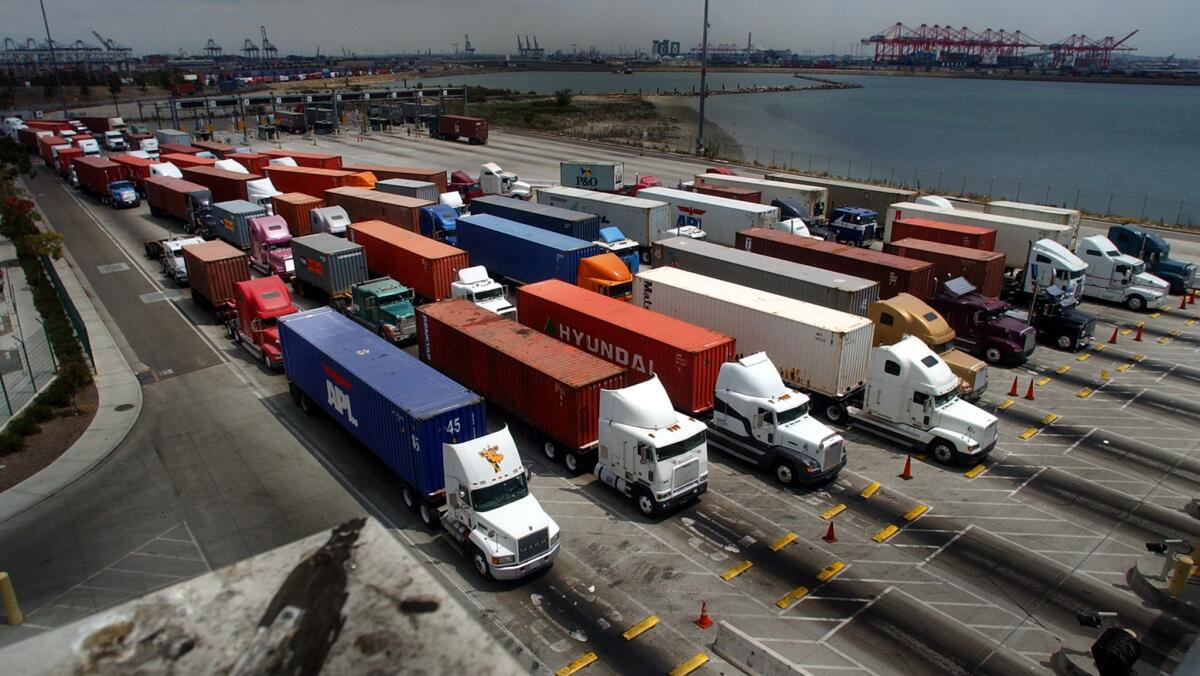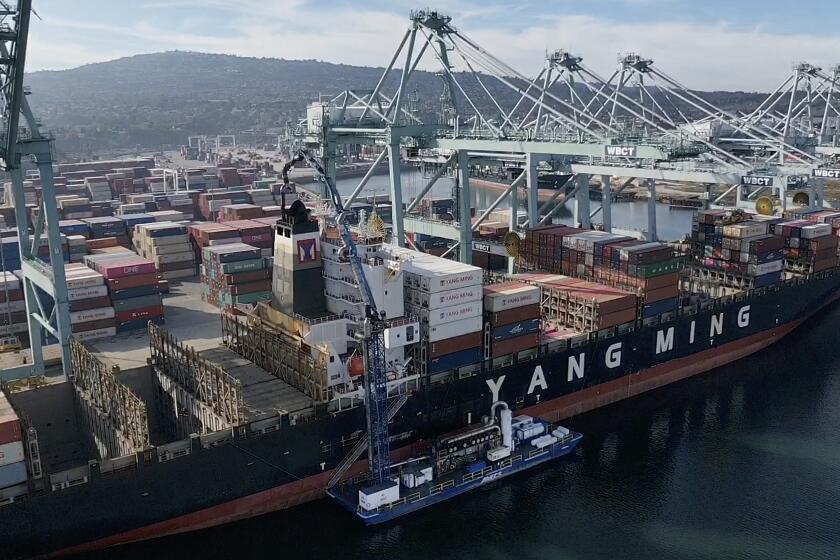L.A.-Long Beach ports approve truck fee too low to clean smog, groups charge

Los Angeles and Long Beach officials voted Monday to impose a modest fee on shipping containers moving through the nationâs largest port complex, in a first step toward helping truckers replace their diesel vehicles with lower-polluting models.
The decision by harbor commissioners, which followed hours of public testimony at a joint hearing in Long Beach, was a disappointment to environmentalists, community groups and air quality officials. They criticized the fee as insufficient to meet greenhouse gas reduction targets and said it will do little to reduce health damage in communities across Southern California that suffer from some of the nationâs worst-polluted air.
Mayoral appointees overseeing the publicly owned ports set a fee of $20 per loaded 40-foot shipping container, on the low end of the range studied. They cited a desire for caution as cargo traffic slumps because of President Trumpâs trade war with China and a global slowdown in goods movement from the coronavirus. They said they also sought to protect truckers from shouldering the cost of cleaning the air.
Los Angelesâ harbor commission approved the fee unanimously, while Long Beach commissioners voted 3-2 in favor.
The decision was a victory for business interests, truck drivers and labor unions who had pushed to keep the fee to a minimum to limit impacts on an economic engine that supports hundreds of thousands of jobs in Southern California.
âThe general consensus was to proceed with caution,â Chris Cannon, director of environmental management for the Port of Los Angeles, told harbor commissioners before the vote. âThe thought was go slow. See whatâs happening. Monitor, evaluate and adjust.â
Regulators are mulling tougher pollution restrictions on docked ships, set to become the biggest source of smog-forming pollution in Southern California.
The fees will be paid by cargo owners, including retailers and manufacturers, and would go into a fund to pay help truckers switch to cleaner vehicles. It marks the first significant step in a revamped clean-air plan the ports adopted in 2017, but at the same time raises doubts about whether they are on a path to reaching L.A. Mayor Eric Garcetti and Long Beach Mayor Robert Garciaâs goals, including their target of switching to zero-emission trucks by 2035.
Joseph Lyou, president of the Coalition for Clean Air, said the ports âlost an opportunity to prioritize public health over the profits of Amazon, Walmart, and other retailers who make money using dirty diesel trucks to move their products,â and in so doing, âundermined their promises to clean up their operations.â
Despite dramatic improvements in air quality, the ports remain the largest source of pollution in Southern California, contributing to smog across the Los Angeles Basin and subjecting harbor-area communities such as Wilmington and West Long Beach to the regionâs highest cancer risk from air pollution and higher rates of asthma compared with the rest of the state.
The portsâ plan exempts zero-emission trucks from the fee. But commissioners delayed action on how long to exempt lower-polluting natural gas trucks, saying they will return in four months to decide that before the fees take effect later this year.
While harbor commissioners backing the $20 fee argued it was necessary first step that balanced economic and environmental concerns, two commissioners said they could not support it because it lacked protections for truck drivers and was too weak to ease the health damage from port pollution.
âI do not believe we are acting in the interest of future generations,â Long Beach Harbor Commissioner Tracy J. Egoscue said before voting in opposition. âPerhaps we should set the rate higher . . . and lower it when the asthma rates come down.â
Port officials have argued that setting truck fee too high would lead importers to route more of their shipments through less costly ports in on the East Coast and the Gulf.
âClean air obviously is important, but not at the expense of jobs and market share,â David Samperio, a member of the International Longshore and Warehouse Union Local 13 from San Pedro, said at the hearing.
An economic analysis, however, predicted minimal cargo diversion if the ports charged between $10 and $140 per container. The $20 fee the ports opted for will generate an estimated $90 million a year, enough money to help replace about 900 trucks.
Thatâs far too little, according to air quality officials and environmentalists. They say the fee is too low to meet the goals of the portsâ own clean-air goals and will do little to meet a 2023 federal Clean Air Act deadline for Southern California to reduce ozone pollution or face potentially crippling sanctions.
âThe portsâ proposal isnât cautious, itâs negligent,â Ashley Sykora, an environmental law student at UCLA told harbor commissioners, calling it ânothing more than a feeble attempt to give the illusion of progress without necessitating real action.â
Environmental groups pushed for a fee of $100 per container, which they said would create incentives to replace thousands of diesel trucks with lower-polluting models in the next few years. They, along with state and local air quality officials, asked harbor commissioners to postpone their vote to allow time to negotiate a higher fee.
The portsâ original Clean Air Action Plan, launched in 2006 and credited with successfully replacing the oldest, dirtiest trucks, relied on a higher fee of $70 per shipping container.
Today there are more than 18,000 trucks moving cargo through the complex, and they remain overwhelmingly fueled by diesel. Only about 130 of those are fueled by lower-polluting natural gas and 20 are zero emission, according to port officials, who said the introduction of cleaner trucks is happening more slowly than anticipated in 2017.
Gene Seroka, executive director of the Port of L.A., said in an interview that a higher fee would increase pressure on truckers, who would ultimately shoulder the increased costs, while generating money for more natural gas trucks than manufacturers currently have the capacity to make.
âIf I stockpile money, then the cargo owners come and say, what are you doing with our money?â Seroka said. âI am not going to create a bank account and just sit on the money.â
His comments aligned with the concerns of labor unions, truck drivers and business groups who urged the ports to keep the rate low to protect their financial interests and livelihoods.
âWe canât keep paying the cost of cleaning the air,â Jose Garcia, a port truck driver from Long Beach told harbor commissioners. âThe multimillion-dollar corporations are the ones that should be paying â not us, the drivers that are barely making ends meet.
Pollution from the L.A.-Long Beach ports has declined dramatically since they launched a sweeping Clean Air Action Plan in 2006, targeting the dirtiest source of diesel pollution, including heavy-duty trucks and cargo ships.
But in recent years, that progress has waned, with some emissions creeping upward. Concerns about backsliding prompted mayors Garcetti and Garcia to update their joint clean-air program with a new plan that seeks to switch to zero-emission cargo-handling equipment by 2030, and zero-emission trucks by 2035.
Port leaders did not dispute that the truck fee they selected would be insufficient to meet the goals of their clean-air plan. But they emphasized it is only a starting point, and would be reviewed annually to ensure it supports their long-term pollution-reduction targets.
âThe confluence of factors have us come to a conclusion that the best approach is to start at a low number, and then we work from there,â Port of Long Beach Executive Director Mario Cordero said in an interview. âIâm sure people will question our resolve. But to me, we have a resume of success and we are committed to succeed again.â








